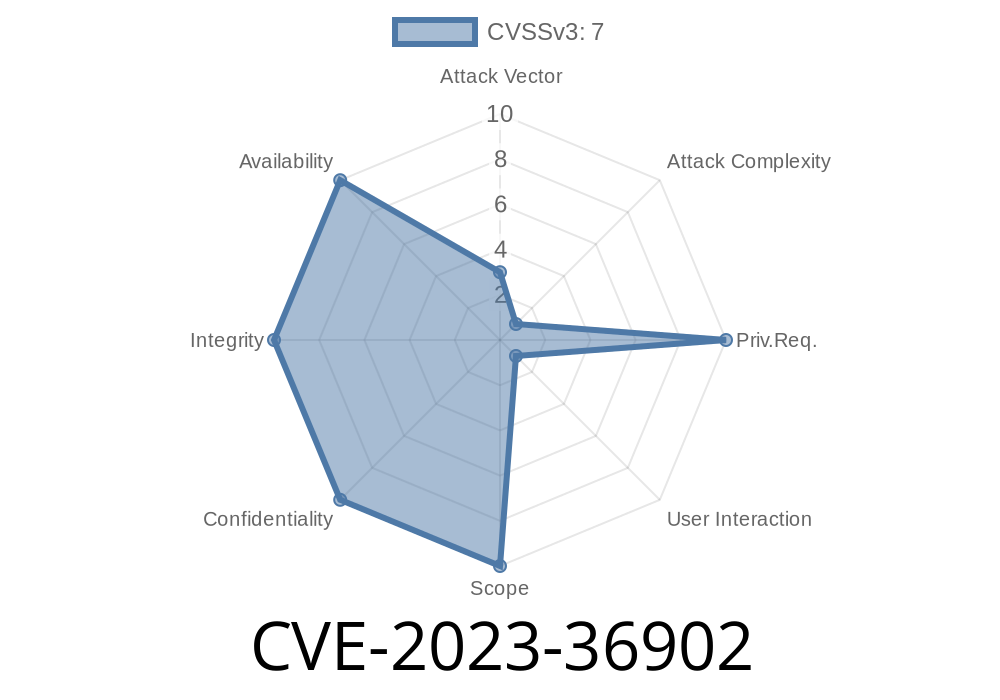In July 2023, Microsoft revealed a critical security issue labeled CVE-2023-36902 that could affect millions of Windows users. This vulnerability exists in the Windows Runtime (also known as WinRT), and if exploited, it can allow remote attackers to execute malicious code on your computer without much interaction. In this comprehensive post, we’ll walk you through what CVE-2023-36902 is, how it can be exploited, why it’s dangerous, and how you can protect yourself. This article is written in simple language for easy understanding!
What is CVE-2023-36902?
*CVE-2023-36902* is a Remote Code Execution (RCE) vulnerability in the Windows Runtime (WinRT) component of Windows, affecting various versions including Windows 10, Windows 11, and Windows Server editions.
Windows Runtime (WinRT)
WinRT is a platform that allows Windows applications to run smoothly and interact with system resources. Because WinRT is used by a lot of built-in and third-party apps, a vulnerability here can have a far-reaching impact.
The Technical Details
The flaw is caused by improper handling of objects in memory within WinRT. This poor memory management can let an attacker run any code they want (with the same privileges as the user) if they can convince you to interact with malicious content, such as a webpage or a specially crafted application.
Microsoft’s official advisory:
Microsoft Security Response Center – CVE-2023-36902
Embedding malicious code in a website or document
If you interact with the malicious content, remote code (malicious software) is run on your system through vulnerable WinRT APIs.
Simple Exploitation Example
Suppose there’s a vulnerable WinRT API (this is a pseudo-code demonstration for educational purposes):
# Attacker's malicious script targeting the vulnerable WinRT API
from winrt.windows.security.cryptography import CryptographicBuffer
def trigger_vulnerability():
# Malicious code abuses improper memory handling
malicious_payload = b'BadStuff' * 10000 # Overflow input to crash or hijack execution
buffer = CryptographicBuffer.create_from_byte_array(malicious_payload)
# Vulnerable API fails to check the buffer's bounds, leading to code execution
trigger_vulnerability()
*Note: This is a simplified scenario. Real-world exploits can be far more complex and may use obscure APIs or specially-crafted data formats.*
Proof-of-Concept (PoC) and Exploitation
On July 11, 2023, researchers unveiled early proof-of-concept (PoC) details (without making public exploit code) that confirmed the bug could be triggered remotely.
Exploit Flow
1. Attacker creates a malicious file/app that interacts with WinRT.
Here is a basic C# code snippet interacting with WinRT (again, simplified to illustrate the API use)
using Windows.Security.Cryptography;
byte[] maliciousInput = new byte[10000]; // Large, crafted input
var buffer = CryptographicBuffer.CreateFromByteArray(maliciousInput); // Triggers flaw
// Outside user’s control: attacker abuses this to hijack program flow
Official References and Resources
- Microsoft Security Advisory: CVE-2023-36902
- NIST NVD Record
- Microsoft Update Catalog
Final Thoughts
CVE-2023-36902 is a critical reminder that keeping your system updated is not optional. Memory corruption bugs like this can be devastating, but the fix is simple—install the provided security patches.
Stay safe, and always verify your sources before opening files or clicking on links! If you want to dig deeper, check out the links above for official advisories and detailed technical reports.
*Written exclusively for this forum – stay tuned for more clear breakdowns of today’s security issues!*
Timeline
Published on: 10/10/2023 18:15:17 UTC
Last modified on: 10/12/2023 22:19:39 UTC
